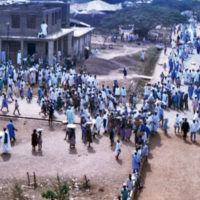VIENNA – January 2019 is Human Trafficking Awareness Month. According to the United Nations 2018 Global Report on Trafficking in Persons released this month, human trafficking has “taken on horrific dimensions.”

The report, which compiles data from 142 countries, was published in two booklets. The first is typical of the annual report from a global perspective. The second looks specifically to the matter of human trafficking in the context of armed conflict.
Identified cases of human trafficking increased by 25% from the previous year. Readers are cautioned to remember that the UN Office of Drugs and Crime (UNODC) does not measure the actual numbers of cases or victims of human trafficking, but only the known cases.
The UNODC cannot say with certainty that the increased number of known cases and victims is a result of more effective law enforcement or because there has been a significant increase in human trafficking per se. However, there are some facts that are undeniable.
- Increases in the numbers of detected victims have been more pronounced in Asia and – wait for it – the Americas.
- The wealthiest countries are the destinations for long-distance trafficking, Victims are lured by promises of prosperity that dissolve into the despair of bondage. This is referred to as “destination trafficking.”
- Women and girls are the most common victims of human trafficking. Although the percentages vary by region, the global data suggests that 72% of all human trafficking involves the enslavement of women and young girls.
- Sexual exploitation and forced labor are the two most prevalent purposes of trafficking.
- Others common forms of human trafficking include illegal adoption, forced criminality, forced begging, production of pornography, forced recruitment as military combatants, and organ removal.
- Organ harvesting is becoming the most lucrative form of human trafficking. Unscrupulous doctors may pay a poverty-stricken donor $10,000 for a kidney, then make $200,000 from a transplant recipient. Between five and 10 percent of all kidney and liver donations worldwide are derived from human trafficking.
- Armed conflicts are a breeding ground for exploitation, especially for children separated from their families and traveling
- The internet – especially social media – is increasingly used as a means of entrapment.
The Polaris Project, a Washington, DC-based, anti-human trafficking NGO, notes that “Human trafficking is notoriously underreported.” In 2017 alone, the Polaris National Human Trafficking Hotline and BeFree Textline handled 8,759 cases of human trafficking involving 10,615 individual victims, 5,000 traffickers, and 1,698 trafficking businesses – in the United States alone!
It is regrettable that human trafficking occurs at all; perhaps even more so that it has become a multi-billion-dollar criminal industry that denies freedom to 24.9 million people around the world.
To read more news on exploitation and 21st century slavery on Missions Box, go here.
Sources:
- NPR, Human Trafficking Reaches ‘Horrific’ New Heights, Declares U.N. Report
- Polaris, The Typology of Modern Slavery
- United Nations Office on Drugs and Crime, Global Report on Trafficking in Persons 2018
Image Source:
- Lembagai KITA [CC BY-SA 4.0], from Wikimedia Commons




